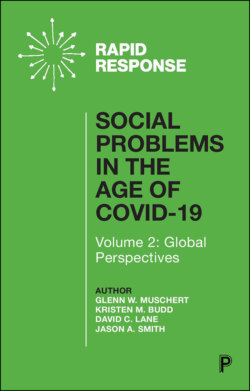Читать книгу Social Problems in the Age of COVID-19 Vol 2 - Группа авторов - Страница 11
Research Evidence
ОглавлениеWhile information and exact numbers related to how the current COVID-19 pandemic is impacting human trafficking is still being collected, the data that have already been gathered by organizations working with survivors of human trafficking point to a concerning trend. As has already been discussed, the COVID-19 pandemic and subsequent social distancing practices have led to increased isolation and increased risk for those impacted by human trafficking. At the same time, service providers and anti-trafficking organizations working to identify and support human trafficking survivors are facing new struggles as support from community members and funding agencies decreases, which in turn leads to a decrease in their ability to assist. According to the Network Against Human Trafficking and Slavery, this includes a decrease in donations, a limited ability to fundraise and hold fundraising events due to social distancing requirements, and a decrease in the number of individuals willing to work as volunteers due to fear of exposure. It also includes a decrease in funding from grants, as funding agencies have shifted their funding priorities to focus on combating and mitigating other effects of the pandemic. Other needs that have been noted include increased training for first responders and service providers, increased services and support such as all forms of healthcare, increased outreach/awareness efforts targeting those interacting with the public such as grocery store workers and those operating food banks, and expanded virtual platforms for training and outreach.
A report from the United Nations Office on Drugs and Crime (UNODC) noted ways that the COVID-19 pandemic has made it more difficult for those impacted by trafficking to seek help. Many shelters for survivors have been forced to close, as social distancing within a shelter environment is difficult to achieve. In addition, human trafficking survivors who had been granted temporary immigration visas now face difficulty during the renewal process. If they are unable to renew the visas, they are more likely to have to return to a dangerous environment. There have also been reports of landlords taking advantage of tenants facing unemployment and eviction, and requesting sex in lieu of rent payments.
We can also look to research conducted during previous pandemics that has identified ways that risks for trafficking are exacerbated through these and other types of disasters and crises. The UNODC, for example, has noted that countries that had experienced pandemics were likely to see increases in trafficking. Reasons for this include increased isolation and stigma, separation from and death of family members, and an influx of people into the country as outsiders arrive to provide support. As another example, a report published by Plan International shows that 10 percent of children knew of girls forced into prostitution after losing a family member during the 2014–16 Ebola outbreak. Another report from the same organization shows that Sierra Leone saw an increase in exploitation against women and girls, as well as an increase in teen pregnancies, during and after the Ebola outbreak.
